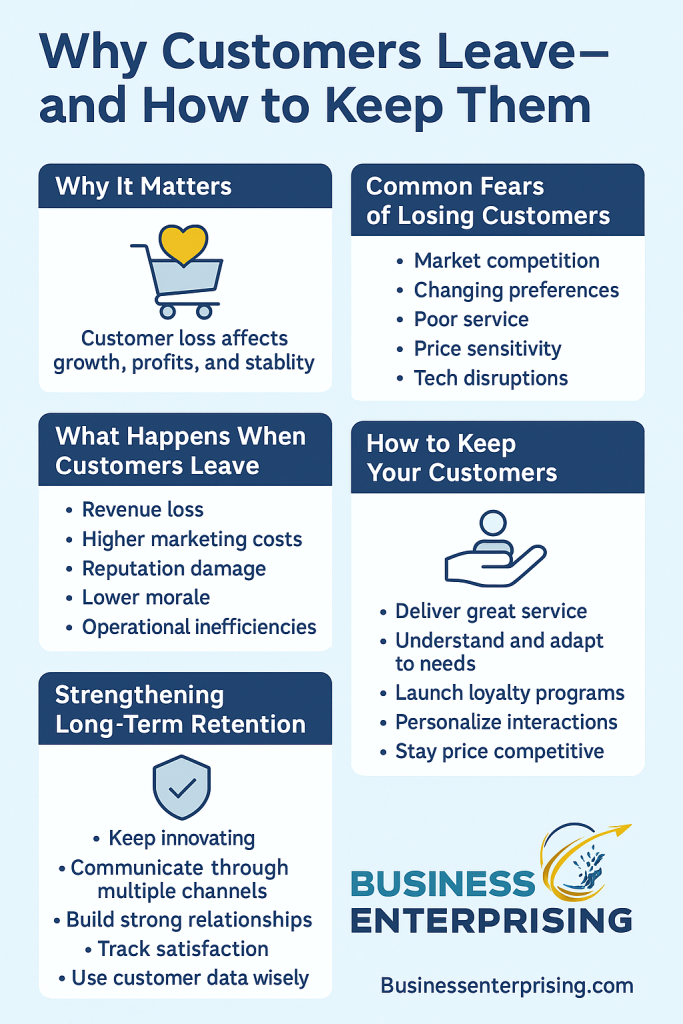
Understanding the Fear of Losing Customers
The fear of losing customers is not unfounded; indeed, several factors contribute to this anxiety.
Firstly, regarding market competition, businesses constantly vie for the same customers. Moreover, competitors often offer better prices, superior products, or enhanced services, which consequently poses a threat to customer loyalty.
Furthermore, changing consumer preferences add to this challenge. As customer tastes evolve over time, businesses must remain attuned to these changes and adapt accordingly. Otherwise, customers might seek alternatives that better meet their needs.
In addition, service quality plays a significant role. Specifically, poor customer service is a notable driver of customer attrition. Thus, negative experiences can easily lead customers to switch to competitors who provide better service.
Additionally, price sensitivity further intensifies this issue. Due to economic conditions and financial constraints, customers become more responsive to price differences. Therefore, if a competitor offers similar products at a lower price, customers may be tempted to switch.
Finally, technological advancements also contribute considerably to this concern. In this regard, rapid technological progress can disrupt traditional business models. Consequently, companies that fail to innovate and keep pace with technology risk losing clients to more tech-savvy competitors.
Impacts of Losing Clients
The loss of customers can have far-reaching impacts on a business:
Revenue Decline: Fewer customers directly translate to reduced sales and revenue. This can affect the business’s ability to cover operational costs and invest in growth opportunities.
Increased Marketing Costs: Another key point is that acquiring new customers is often more expensive than retaining existing ones. Businesses may need to increase their marketing spend to attract new customers and replace those they have lost.
Brand Reputation: High customer turnover can damage a brand’s reputation. Dissatisfied customers may leave negative reviews or share their experiences with others, deterring potential customers.
Employee Morale: A decline in customer numbers can affect employee morale. Employees may feel insecure about their job stability, leading to decreased motivation and productivity.
Operational Disruptions: Fluctuations in customer numbers can disrupt business operations. For instance, inventory management, staffing, and resource allocation may become challenging to manage efficiently.
Strategies to Enhance Customer Retention
To mitigate the loss of clients, businesses should focus on enhancing customer retention. Here are several effective strategies to avoid losing customers:
Deliver Exceptional Customer Service: Providing outstanding customer service is key to retaining customers. Train employees to be courteous, responsive, and solution-oriented. Address customer issues promptly and go the extra mile to exceed their expectations.
Understand and Adapt to Customer Needs: Regularly engage with customers to understand their needs and preferences. Use surveys, feedback forms, and social media interactions to gather insights. Adapt your products and services based on this feedback to stay relevant.
Implement a Loyalty Program: Loyalty programs can incentivize repeat business. Offer rewards, discounts, or exclusive benefits to loyal customers. This not only encourages repeat purchases but also strengthens the customer’s connection to your brand.
Personalize Customer Interactions: Personalization can also significantly enhance customer experiences. Use customer data to tailor marketing messages, product recommendations, and communications. Personalized interactions make customers feel valued and appreciated.
Maintain Competitive Pricing: Regularly review your pricing strategy to ensure it remains competitive. While it’s important to maintain profitability, competitive pricing can help retain price-sensitive customers.
More Ways to Keep Clients
Innovate and Stay Relevant: Continuously innovate to stay ahead of market trends and technological advancements. Introduce new products, services, or features that add value to your customers. Keeping your offerings fresh and relevant can prevent customers from seeking alternatives.
Engage Through Multiple Channels: Use multiple communication channels to engage with customers. Social media, email marketing, and mobile apps provide various touchpoints to interact with customers, share updates, and offer promotions.
Build Strong Relationships: Focus on building strong, long-term relationships with customers. Show appreciation through thank-you notes, special offers, and personalized messages. Strong relationships foster loyalty and reduce the likelihood of customer attrition.
Monitor Customer Satisfaction: Regularly monitor customer satisfaction levels using surveys and feedback tools. Identify areas for improvement and take corrective actions promptly. High customer satisfaction is directly linked to higher retention rates.
Analyze and Act on Customer Data: Finally, leverage data analytics to gain insights into customer behavior and preferences. Use this information to refine your marketing strategies, improve customer experiences, and proactively address potential issues.
The fear of losing customers is a legitimate concern for business owners, given the significant impacts on revenue, reputation, and operational stability. However, by focusing on customer retention strategies, businesses can mitigate this fear and foster a loyal customer base. Delivering exceptional customer service, understanding customer needs, implementing loyalty programs, as well as staying competitive and innovative are crucial steps in retaining customers.
In today’s dynamic market, businesses that prioritize customer satisfaction and loyalty are more likely to thrive and achieve long-term success. By building strong relationships and continuously adapting to customer expectations, businesses can not only retain their customers but also turn them into brand advocates, driving sustained growth and profitability.


